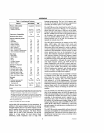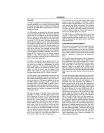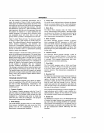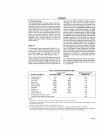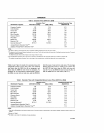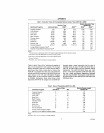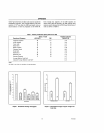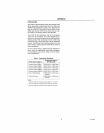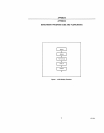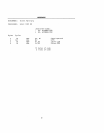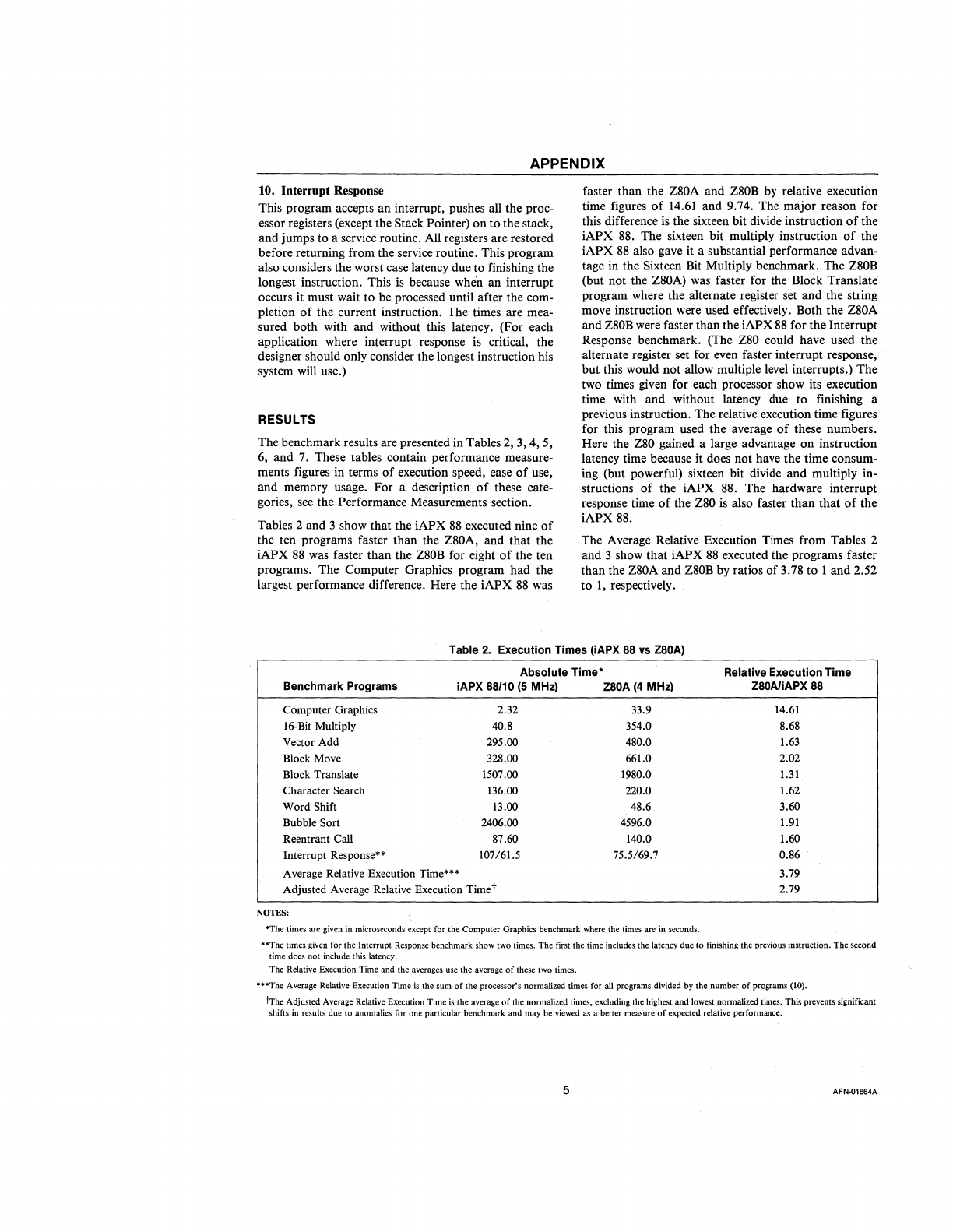
APPENDIX
10. Interrupt Response
This program accepts an interrupt, pushes all the
proc-
essor registers (except the Stack Pointer) on
to
the stack,
and jumps to a service routine.
All
registers are restored
before returning from the service routine. This program
also considers the worst case latency due to finishing the
longest instruction. This
is
because when an interrupt
occurs
it
must wait to be processed until after the com-
pletion
of
the current instruction. The times are mea-
sured both with and without this latency. (For each
application where interrupt response
is
critical, the
designer should only consider the longest instruction his
system
will
use.)
RESULTS
The benchmark results are presented in Tables 2, 3,
4,5,
6,
and
7.
These tables contain performance measure-
ments figures in terms
of
execution speed, ease
of
use,
and memory usage. For a description
of
these cate-
gories,
see
the Performance Measurements section.
Tables 2 and 3 show that the
iAPX
88
executed nine
of
the ten programs faster than the Z80A, and that the
iAPX
88
was
faster than the
Z80B
for eight
of
the ten
programs. The Computer Graphics program had the
largest performance difference. Here the iAPX
88
was
faster than the
Z80A and
Z80B
by
relative execution
time figures
of
14.61
and 9.74. The major reason for
this difference
is
the sixteen bit divide instruction
of
the
iAPX
88.
The sixteen bit multiply instruction
of
the
iAPX
88
also gave it a substantial performance advan-
tage in the Sixteen Bit Multiply benchmark. The Z80B
(but not the Z80A) was faster for the Block Translate'
program where the alternate register set and the string
move instruction were used effectively. Both the
Z80A
and
Z80B
were faster than the iAPX
88
for the Interrupt
Response benchmark. (The
Z80 could have used the
alternate register set for even faster interrupt response,
but this would not allow multiple
level
interrupts.) The
two times given for each processor show its execution
time with and without latency due
to
finishing a
previous instruction. The relative execution time figures
for this program used the average
of
these numbers.
Here the
Z80
gained a large advantage on instruction
latency time because it does not have the time
consum-
ing (but powerful) sixteen bit divide and multiply in-
structions
of
the iAPX
88.
The hardware interrupt
response time
of
the Z80
is
also faster than that
of
the
iAPX
88.
The Average Relative Execution Times from Tables 2
and 3 show that iAPX
88
executed the programs faster
than the
Z80A and Z80B by ratios of 3.78
to
1 and 2.52
to
1,
respectively.
Table
2.
Execution Times (iAPX 88
vs
ZSOA)
Absolute Time"
Benchmark Programs iAPX
88110
(5
MHz)
ZSOA
(4
MHz)
Computer
Graphics
16-Bit Multiply
Vector
Add
Block Move
Block Translate
Character Search
Word
Shift
Bubble
Sort
Reentrant Call
Interrupt Response"
2.32
40.8
295.00
328.00
1507.00
136.00
13.00
2406.00
87.60
107/61.5
Average Relative Execution
Time'·'
Adjusted Average Relative Execution
Timet
NOTES:
33.9
354.0
480.0
661.0
1980.0
220.0
48.6
4596.0
140.0
75.5/69.7
*The
times
are
given
in
microseconds
except
for
the
Computer
Graphics
benchmark
where
the
times
are
in
seconds.
Relative Execution Time
Z80AlIAPX 88
14.61
8.68
1.63
2.02
1.31
1.62
3.60
1.91
1.60
0.86
3.79
2.79
··The
times
given
for
the
Interrupt
Response
benchmark
show
two
times.
The
first
the
time
includes
the latency
due
to finishing
the
previous
instruction.
The
second
time does not include this latency.
The Relative Execution Time and the averages use the average
of
these two times.
··*The
Average
Relative
Execution
Time
is
the
sum
of
the
processor's
normalized
times
for
all
programs
divided
by
the
number
of
programs
(10).
trhe
Adjusted
Average
Relative
Execution
Time
is
the
average
of
the
normalized
times.
excluding
the
highest
and
lowest normalized
times.
This
prevents
significant
shifts
in
results
due
to
anomalies
for
one
particular
benchmark
and
may
be
viewed
as
a
better
measure
of
expected
relative
performance.
5 AFN·01664A








